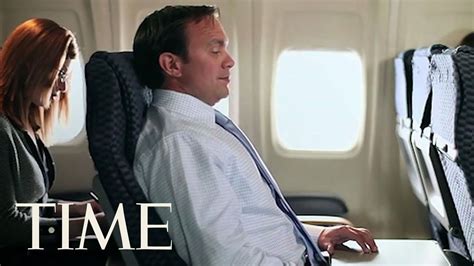
Reclining your airplane seat, a long-debated etiquette issue, could now lead to financial penalties on some airlines, particularly in situations where it causes damage or injury, highlighting a shift in how airlines are addressing passenger behavior.
Reclining airplane seats, a source of perennial passenger friction, are now under increased scrutiny as some airlines consider holding passengers financially accountable for damages or injuries caused by excessive reclining. This potential shift towards penalizing disruptive reclining behavior comes as airlines grapple with maintaining order and passenger comfort within the confined space of an airplane cabin. The issue has sparked debate among travelers, with some viewing reclining as an inherent right purchased with their ticket and others considering it an inconsiderate encroachment on fellow passengers’ space.
According to a recent Yahoo! Lifestyle report, passengers who recline their seats excessively and cause damage or injury to the person behind them could face fines. This represents a notable escalation in how airlines are addressing in-flight etiquette and passenger disputes, moving beyond mere verbal warnings or requests for compliance.
The impetus for this potential change stems from an increase in reported incidents of “Knee Defender” type devices being used to prevent seat reclining, confrontations between passengers regarding reclining etiquette, and a general rise in awareness of the discomfort that reclining can cause, especially on shorter flights or when passengers are working or eating. While the specific policies and enforcement mechanisms are still evolving, the message is clear: airlines are taking a firmer stance against reclining-related disruptions.
The debate over reclining airplane seats is not new. For years, travelers have argued about the appropriateness of reclining, with opinions varying widely depending on personal space preferences, flight duration, and perceived impact on other passengers. The rise of social media has amplified these debates, with videos of reclining-related conflicts often going viral and further fueling the controversy.
Advocates for reclining argue that passengers have a right to use the features of their purchased seat, including the recline function. They point out that airlines design seats to recline and that passengers should be able to enjoy this feature, especially on long-haul flights. This perspective often emphasizes the importance of personal comfort and relaxation during air travel.
Conversely, opponents of reclining argue that it significantly reduces legroom for the passenger behind, making it difficult to work, eat, or even move comfortably. They argue that reclining is particularly problematic on shorter flights where the benefit of reclining is minimal compared to the inconvenience it causes. Some passengers also point out that reclining can be especially challenging for taller individuals or those with mobility issues who already struggle with limited legroom.
The potential for fines adds a new dimension to this ongoing debate. It suggests that airlines are increasingly willing to intervene in passenger disputes and enforce standards of conduct that prioritize the comfort and safety of all travelers. However, the implementation of such policies raises several questions about fairness, enforcement, and the potential for misinterpretation.
One of the key challenges is defining what constitutes “excessive” reclining. Airlines will need to establish clear guidelines on the degree to which seats can be reclined without causing undue discomfort or risk of injury to other passengers. This may involve considering factors such as flight duration, seat pitch (the distance between rows), and the physical characteristics of the passengers involved.
Another challenge is determining liability for damages or injuries. If a passenger is injured by a reclined seat, it may be difficult to determine whether the recline was the direct cause of the injury or whether other factors, such as pre-existing conditions or the passenger’s own actions, contributed to the incident. Airlines will need to develop protocols for investigating such incidents and assessing responsibility.
Enforcement of reclining-related fines also presents logistical challenges. Flight attendants, who are already responsible for a wide range of safety and service duties, will likely be tasked with monitoring reclining behavior and issuing warnings or citations as necessary. This could place additional strain on flight crews and potentially lead to conflicts with passengers who dispute the validity of the fines.
Despite these challenges, the potential for fines reflects a growing trend towards stricter enforcement of passenger behavior on airlines. In recent years, there have been increasing reports of unruly passenger incidents, ranging from verbal abuse to physical altercations. Airlines are under pressure to maintain order and safety in the cabin and are exploring various strategies to deter disruptive behavior.
The implementation of reclining-related fines could be seen as part of this broader effort to promote a more respectful and considerate travel environment. By holding passengers accountable for their actions, airlines may be able to reduce the incidence of reclining-related disputes and improve the overall travel experience for everyone.
However, the success of this approach will depend on several factors, including clear communication of the rules, fair and consistent enforcement, and a willingness by passengers to respect the rights and comfort of their fellow travelers. The airlines that implement such policies may face public backlash if the policies are not perceived to be fair and equitable.
The legal basis for imposing fines for reclining-related incidents is also important to consider. Airlines typically have broad authority to set rules and regulations for passenger conduct, but these rules must be reasonable and consistent with applicable laws and regulations. Passengers who believe they have been unfairly fined may have legal recourse to challenge the fines in court. The specifics of the airline’s terms and conditions will dictate the processes involved in disputes.
For now, passengers are advised to exercise caution and consideration when reclining their seats. Before reclining, it is courteous to check whether the person behind is working, eating, or has limited legroom. If there is a potential conflict, it may be possible to negotiate a compromise, such as reclining only partially or refraining from reclining altogether. The use of “Knee Defenders” or other devices designed to prevent reclining is generally discouraged, as these devices can pose a safety hazard and may be prohibited by airline policies.
Ultimately, the issue of reclining airplane seats reflects a broader challenge of balancing individual rights and responsibilities in a shared public space. As airlines continue to explore ways to manage passenger behavior, it is important to find solutions that are fair, effective, and respectful of the needs of all travelers. This includes the need to be communicative and polite when engaging with your fellow passengers.
In-Depth Analysis and Expanded Context:
The announcement that airlines might start fining passengers for excessively reclining their seats represents a significant escalation in the ongoing battle for space and comfort within the confines of an airplane cabin. This shift moves beyond the usual passive-aggressive responses like sighing loudly or subtly kicking the seat and enters the realm of financial consequences. To fully understand the implications of this potential policy change, it’s necessary to examine the various factors contributing to the reclining seat controversy, the potential challenges of implementation, and the broader context of passenger rights and airline responsibilities.
Historical Perspective and the Evolution of Cabin Space:
The issue of reclining seats isn’t new. As air travel has become more accessible and affordable, airlines have sought to maximize revenue by squeezing more seats into the same amount of space. This has resulted in a gradual reduction in seat pitch, which is the distance between a point on one seat and the same point on the seat in front of it. In the past, a seat pitch of 34-36 inches was common in economy class. Today, many airlines offer a seat pitch of just 30-31 inches, and some budget carriers have even less. This shrinking legroom has naturally intensified the debate over reclining, as even a slight recline can significantly impact the already limited space of the passenger behind.
The Psychology of Reclining:
The act of reclining is often rooted in a desire for increased comfort and relaxation, especially on long flights. Passengers may recline to alleviate back pain, improve sleep quality, or simply to create a more comfortable personal space. However, the psychological impact of reclining on the passenger behind can be quite different. A reclined seat can feel like an invasion of personal space, leading to feelings of frustration, anger, and even anxiety. This is particularly true for taller passengers or those with claustrophobia.
The conflict arises from differing perceptions of personal space and the expectation of consideration for others. Some passengers believe they have a right to recline their seat because it’s a feature provided by the airline. Others believe that reclining should be done sparingly and with consideration for the person behind. This clash of expectations often leads to confrontations and escalating tensions.
The Economics of Airline Seating:
Airlines face a complex balancing act between maximizing revenue, controlling costs, and providing a reasonable level of comfort for passengers. The decision to reduce seat pitch is primarily driven by economic considerations. By fitting more seats into the cabin, airlines can increase the number of passengers per flight, which translates to higher revenue. However, this comes at the expense of passenger comfort and increases the likelihood of reclining-related conflicts.
Some airlines have experimented with different seating configurations and pricing models to address this issue. For example, some offer “premium economy” seats with more legroom and recline, while others charge extra for seats in exit rows or bulkhead seats that offer more space. These options allow passengers to pay for additional comfort and potentially avoid the reclining dilemma altogether.
Legal Considerations and Airline Liability:
The legal aspects of reclining-related incidents are complex and often depend on the specific circumstances of the case. Airlines have a general duty to provide a safe and comfortable environment for passengers, but this duty is not absolute. Passengers are also expected to exercise reasonable care for their own safety and the safety of others.
If a passenger is injured as a result of a reclined seat, they may be able to file a claim against the airline, the reclining passenger, or both. However, to succeed in such a claim, the injured passenger would need to prove that the airline or the reclining passenger was negligent and that this negligence directly caused the injury. This can be difficult to do, as there may be other factors that contributed to the injury, such as pre-existing medical conditions or the passenger’s own actions.
The potential for fines for excessive reclining could change this dynamic by creating a clearer standard of conduct and providing a mechanism for airlines to hold passengers accountable for their actions. However, the implementation of such fines would need to be carefully considered to ensure that they are fair, reasonable, and consistent with applicable laws and regulations.
Enforcement Challenges and Potential Solutions:
Enforcing reclining-related fines presents several practical challenges. Flight attendants are already responsible for a wide range of safety and service duties, and adding the task of monitoring reclining behavior and issuing citations could place additional strain on them. It could also lead to conflicts with passengers who dispute the validity of the fines.
One potential solution is to provide flight attendants with clear guidelines and training on how to assess reclining-related incidents and issue warnings or citations. It may also be helpful to develop a system for documenting these incidents and providing passengers with an opportunity to appeal the fines.
Another approach is to focus on preventative measures, such as educating passengers about reclining etiquette and providing alternative seating options with more legroom. Some airlines have also experimented with “pre-reclined” seats that offer a fixed amount of recline without impacting the passenger behind.
The Role of Technology:
Technology could also play a role in resolving the reclining seat controversy. For example, some companies are developing sensors that can detect when a seat is reclined and automatically adjust the legroom of the seat behind. Other technologies could be used to provide passengers with real-time information about seat pitch and recline angles, allowing them to make more informed decisions about where to sit.
Broader Implications for Passenger Rights and Airline Responsibilities:
The reclining seat debate is just one example of the broader challenges of balancing passenger rights and airline responsibilities in an increasingly crowded and competitive travel environment. As airlines continue to seek ways to maximize revenue and control costs, it’s important to ensure that passenger comfort and safety are not compromised.
Passengers have a right to expect a reasonable level of comfort and safety when they fly, but they also have a responsibility to be considerate of their fellow travelers. Airlines have a responsibility to provide a safe and comfortable environment, but they also have a right to set reasonable rules and regulations for passenger conduct.
Finding the right balance between these competing interests requires open communication, creative problem-solving, and a willingness to compromise. It also requires a recognition that air travel is a shared experience and that everyone has a role to play in making it as pleasant and comfortable as possible. The use of technologies such as live messaging between passengers can also assist in creating a better environment.
Frequently Asked Questions (FAQs):
1. Can I really be fined for reclining my airplane seat?
Potentially, yes. While not all airlines currently impose fines for reclining, the Yahoo! Lifestyle article suggests that some airlines are considering or may already be implementing policies where passengers could face financial penalties if their reclining causes damage or injury to another passenger. It’s crucial to check the specific airline’s policies before flying. “Passengers who recline their seats excessively and cause damage or injury to the person behind them could face fines,” as stated in the source article.
2. What constitutes “excessive” reclining? How will airlines determine if my recline warrants a fine?
Defining “excessive” is a challenge. Airlines will likely need to establish clear guidelines based on factors such as flight duration, seat pitch, and the physical characteristics of the passengers involved. It is also important to note the specific airline’s definitions as part of their terms and conditions. A passenger’s subjective discomfort is unlikely to trigger a fine; demonstrable damage or injury is more likely.
3. What if the person behind me is being unreasonable, such as deliberately kicking my seat or using a “Knee Defender”?
Using a “Knee Defender” or similar device is generally discouraged and may be prohibited by airline policies, as these can pose safety hazards. Deliberately kicking a seat is also unacceptable behavior. In such cases, the best course of action is to alert a flight attendant. The flight attendant is responsible for mediating disputes and ensuring passenger safety and compliance with airline regulations. Documenting the incidents and the flight attendant responses can be important for further action.
4. If I’m injured by a reclined seat, what legal recourse do I have?
If you are injured by a reclined seat, you may be able to file a claim against the airline, the reclining passenger, or both. However, you would need to prove that the airline or the reclining passenger was negligent and that this negligence directly caused your injury. Consult with a legal professional to assess your options and understand the applicable laws and regulations. Gathering evidence such as medical reports, witness statements, and photos of the injury can assist in creating a stronger case.
5. How can I avoid reclining-related conflicts on a flight?
To avoid conflicts, exercise caution and consideration when reclining. Before reclining, check whether the person behind you is working, eating, or has limited legroom. If there is a potential conflict, try to negotiate a compromise, such as reclining only partially or refraining from reclining altogether. Communication and empathy are key to resolving potential disputes amicably. Be polite and respectful when you engage with the other passengers.









